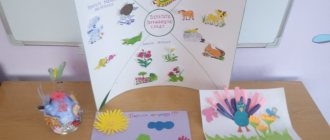ALGORITHMS FOR FAMILIARIZING CHILDREN WITH HOUSEHOLD WORK BY GROUPS
Literature
- Voronkevich O. A. Welcome to ecology. - SPb.: CHILDREN'S PRESS, 2006.
- Golitsina N. S. Organization and conduct of thematic control in preschool educational institutions. - M.: Scriptorium, 2004.
- Golitsina N. S. Organization and content of the work of a senior preschool teacher. - M.: Scriptorium, 2008.
- Kozlova S. A., Kulikova T. A. Preschool pedagogy. - M.: Academy, 2002.
- Methodological recommendations for the program of education and training in kindergarten / Ed. M. A. Vasilyeva, V. V. Gerbova, T. S. Komarova. - M.: Publishing house "Education of preschoolers", 2008.
- Prikhodko E. G., Malyshevich T. V. A new model of educational activities of a teacher in a preschool educational institution. - Krasnodar: World of Kuban, 2006.
Material provided by the magazine PRESCHOOL PEDAGOGY, November 2010
content .. 1 2 3 9 ..Education for labor activity in the first junior group of preschool educational institutions
Due to the age-related capabilities of the child’s body, the labor activity of a child of the 3rd year of life is still very limited. At this stage, the tasks of developing the prerequisites for work activity, the formation of hygienic skills and self-care skills are solved. From the age of 2, children begin to develop an interest in the work of adults and a desire to help them. For example, introducing the work of a nanny, the teacher says: “Look, children, how Anna Ivanovna washes the floor, how she tries to keep the group clean!” Or: “Who was it that scattered the paper on the floor? It will be difficult for Anna Ivanovna to assemble it alone. We will now pick up the rubbish together with Olya, Ira and Seryozha... The children did a good job! They love Anna Ivanovna and help her work.” The main thing in the labor education of children of this age is to introduce them to self-service, the formation of simple skills in this type of work. The goal for the child should be set specific, feasible, understandable, taking into account the fact that the child will see the result of the work and feel its necessity for himself:; I fastened the buttons on the sleeves with the help of an adult - it became convenient to play, the sleeves do not fall down on the hands and do not interfere; With the help of the teacher, I laced my shoes - it became comfortable to walk, the laces did not get tangled under my feet; I washed my hands myself - I felt a pleasant feeling of satisfaction, etc. The work activities of young children should take place in a playful way. Playful techniques help create a joyful, emotional mood in children, and consequently, more successful learning of work skills. So, the teacher invites the kids to teach Piggy and turns to the pig: “Learn, Piggy, to take off our guys’ tights! Now look how Sasha can wipe her nose with a handkerchief.” And so on. The formation of certain self-service skills always begins with a direct demonstration of the action, accompanied by an explanation, and then performing the action together with the children. For example, when teaching students to wash their hands, the teacher rolls up the sleeves of his robe, soaps his hands, rubs them, rinses them, wipes them, then encourages the kids to repeat these operations in the same sequence. At the same time, he tries to evoke a joyful mood in children, using poems, nursery rhymes, and songs. For example: Clean water washes Vova’s face, Tanya’s hands, and Antosha’s fingers. While reciting the song, the teacher washes Antosha’s doll’s hands, wipes them and invites the kids to dry their hands with a towel as he shows. While teaching children to take off their clothes, the teacher undresses the doll Masha, who was walking with them. She accompanies her actions with the words: “The doll Masha took off her hat and put it in the closet on the top shelf. Look, Masha, now all the guys will take off their hats and put them in their closets on the top shelves.” Etc. In the learning process, children need benevolent, emotional encouragement, timely help, and support. This stimulates the baby’s activity, causing him joy and satisfaction. From 2 to 3 years old, children learn, with the help of adults, to take off clothes and shoes (unbutton the front buttons, untie the laces), undress in a certain sequence, and neatly fold things. In this age group, it is recommended to involve children in carrying out simple individual tasks (bringing a toy, putting a ball in its place, etc.). If a child refuses to complete an order, you should not insist. It is better to use a gaming technique. For example, a teacher may say: “What a big car Vova has! Using such a vehicle, he will now quickly transport all the cubes that are lying on the floor and put them neatly on the shelf.” Or: “Our good housewife Olya, she will now pick up all the rags from the floor, fold them and hide them in the closet, and her house will be clean and tidy.” In household work, familiarization of children with a new labor operation should begin with the joint activity of the child with an adult. First, the teacher turns to the child with a request, for example, to help wipe the table. Then he tells and shows what needs to be done, calmly and kindly encouraging the child to work with him. For example: “Today Tanya will help me wipe the tables with damp cloths. These are some beautiful rags we have! This is how you need to fold a cloth and wipe the table with it: both the middle and all the corners. Tanechka worked well, how clean she wiped her table, it would have been difficult for me alone without her, I would have had to work for a long time!” Such joint activities especially help in establishing contact between a child and an adult. During work, special attention should be paid to instilling humane feelings and positive relationships in children, encouraging the child to be responsive and compassionate (“Kolya, let’s help Olya collect the cubes... That’s how friendly we are! We cleaned everything up quickly!”). The teacher should give children examples of affectionate, friendly treatment. For example, picking up a doll from the floor, the teacher asks it: “Who lost you, who is your mother? Tanya is your mother? Take my daughter, Tanya, have pity, put her in the stroller.” The creation of a friendly, emotional atmosphere in the group is facilitated by the playful technique of the episodic appearance of toys and the teacher’s conversation with the children on behalf of one or another character. For example, grandma Varvarushka, bear Toptyzhka or other fairy-tale characters may come to the kids and praise them, encourage them with affectionate words or make comments in a gentle form (“Our bear Toptyzhka noticed that Sasha is bad at putting away toys”; “Zhenya, you can’t knock a toy on a toy, this could cause them to break"). The teacher constantly instills in children a caring attitude towards all living things, teaches them to take care of the inhabitants of a corner of nature. The personal example of an adult is especially effective. So, while caring for the bird, the teacher says: “Good, beautiful bird, you are so small, we all love you, now we’ll pour some water, give some grains so that you can always sing your songs to us.” Etc. It is necessary to create in children the prerequisites for joint activities, encouraging children to briefly interact with each other, teach them to work together without interfering with each other, and show sympathy for peers (“Look, Andryusha, how difficult it is for Verochka to pick up the cubes alone and put them on the shelf! Go tell her: let's work together!" Or: "Guys! Don't you know why our bunny is smiling? Let's ask him... He told me in my ear that he was very happy. He likes how Andryusha and Irochka work together"). Didactic games such as “Let’s put the bunny to sleep”, “Let’s dress the doll Nastya”, “Treat the dolls”, etc. also contribute to children’s learning of labor skills.
content .. 1 2 3 9 ..
TASKS OF LABOR EDUCATION OF PRESCHOOL CHILDREN BY GROUPS
1st junior group
1. Foster respect for people of any profession.
2. Emphasize the significance of the results of their work.
3. Support children's desire to help adults.
4. Introduce children to self-care
2nd junior group
Cultivate a desire to take part in work activities as much as possible.
Middle group
1. Foster a positive attitude towards work and a desire to work.
2. Learn to carry out individual and collective assignments, develop the ability to negotiate with the help of a teacher about the distribution of work, and take care of the timely completion of a joint task.
3. Form the beginnings of a responsible attitude towards the assigned task (the ability and desire to complete the work started, the desire to do it well).
4. Explain to children the importance of their work.
5. Encourage initiative in helping comrades and adults.
Senior group
1. Continue to expand children’s understanding of adult work. Show the results of labor and its social significance. Systematize knowledge about people’s work at different times of the year.
2. Talk about the professions of teacher, doctor, builder, workers in agriculture, transport, clothing industry, trade, etc.
3. Explain that a variety of equipment is used to make work easier (computer, cash register, electric sewing machine, etc.).
4. Introduce children to the work of people in creative professions: artists, writers, composers, masters of folk arts and crafts. Show the results of their work: paintings, books, sheet music, objects of decorative art.
5. Explain to children that the work of adults is paid, and people spend the money they earn on food, clothing, furniture, and on vacation.
6. Develop a desire together with adults and with their help to carry out feasible work assignments.
7. Learn to finish what you start.
8. Develop creativity and initiative when performing various types of work. Create responsibility for carrying out work assignments.
9. Teach the most economical working methods. Foster a work culture and respect for materials and tools.
10. Learn to evaluate the results of your work with the help of an adult.
11. Stimulate the desire to take part in work activities.
Preparatory group
1. Continue to cultivate interest in various professions and parents’ place of work.
2. Continue to introduce children to professions related to the specific local conditions.
3. Expand ideas about the work of adults. Foster respect for working people.
4. Create the need to work.
5. Foster a love of work.
6. Teach them to diligently and carefully carry out instructions, take care of materials and objects, and put them back in their place after work.
7. Cultivate a desire to participate in joint work activities on an equal basis with everyone else, the desire to be useful to others, to achieve results.
Methodical comment
The introduction of children to work begins with the 1st junior group. The main type of work at this age is self-care.
In the 2nd junior group, children continue to develop a desire for feasible work.
The volume of tasks for labor education increases from the middle group, reaching a maximum in the senior group. It is in the middle group that children actively master various work skills and techniques for working in nature, household and self-service work.
In the older group, manual labor is added. In the older group, greater emphasis is placed on developing all the skills and abilities available to children in various types of work. A conscious attitude and interest in work activities and the ability to achieve results are formed.
In the preparatory group, the developed skills and abilities are improved. But the basic foundation of children’s labor skills is laid in the older group
ON A NOTE. Pretend toys for kindergarten at low prices from the specialized store for teachers “Kindergarten” - detsad-shop.ru
Junior group. Early childhood, nursery. Children 1-4 years old
Summary of a design lesson for young children. “Visiting Doctor Aibolit” Goal: development of sensory and general motor skills of the hands. Objectives: Social and communicative development: cultivate kindness, an emotionally positive attitude towards peers and toys. Cognitive development: clarify and consolidate knowledge about domestic animals and birds (characteristic external...
Organization of design in the development of sensorimotor abilities of young children Organization of design in the development of sensorimotor abilities of young children. Prepared by: teacher Semenyakina N.V. “Yellow cubes are sand, Green cubes are spring forest, Blue cubes are rivers. There are many cubes - the river is wide. Cube by cube – floors grow:...
SELF-CARE: Tasks and content of work in groups
1st junior group
1. To develop in children the ability to take care of themselves independently (while undressing, dressing, washing, eating).
2. Continue to teach children under the supervision of an adult, and then wash your hands yourself when they become dirty and before eating, wipe your face and hands dry with a personal towel.
3. Learn to put yourself in order with the help of an adult.
4. To develop the skill of using individual objects (handkerchief, napkin, towel, comb, pot).
5. Encourage children to be independent when eating, teach them to hold a spoon in their right hand.
6. Teach children how to dress and undress.
7. Learn to take off clothes and shoes (unfasten front buttons, Velcro fasteners) with a little help from an adult.
8. Learn to carefully fold removed clothes in a certain order.
9. Learn to put on clothes and shoes correctly.
2nd junior group
1. Continue teaching children to dress and undress independently in a certain sequence (putting on and taking off clothes, unbuttoning and fastening buttons, folding, hanging clothes, etc.).
2. Develop neatness, the ability to notice disorder in clothing and eliminate it with a little help from adults.
3. Continue to teach how to use soap correctly, carefully wash your hands, face, ears; Wipe yourself dry after washing, hang the towel back, use a comb and a handkerchief.
4. Learn to use tablespoons, teaspoons, forks, and napkins correctly.
Middle group
1. Improve the ability to dress and undress independently; teach to neatly fold and hang clothes with the help of an adult, put them in order - clean, dry
2. Cultivate the desire to always be neat and tidy.
3. Cultivate the habit of washing yourself, washing your hands before eating, when dirty, and after using the toilet.
4. Strengthen the ability to use a comb and handkerchief.
5. When coughing and sneezing, teach people to turn away and cover their nose and mouth with a tissue.
6. Continue to teach how to use cutlery correctly - spoon, fork, knife).
7. Learn to rinse your mouth after eating
Senior group
1. Form the habit of brushing your teeth and washing your face every day, and washing your hands as necessary.
2. Strengthen the ability to dress and undress independently, carefully put clothes in a closet, dry wet things in a timely manner, care for shoes (wash, wipe, clean, put away).
3. Learn to notice and independently eliminate disorder in your appearance.
4. Form the habit of taking care of personal belongings.
5. Develop a desire to help each other
6. Train yourself to brush your teeth and keep your nails clean.
7. Maintain order in your closet, put clothes in certain places
8. Learn to make your bed neatly
Preparatory group
1. Strengthen the ability to dress and undress independently in a certain sequence, correctly and neatly put clothes in the closet, put shoes in place, dry wet things in a timely manner, care for shoes (wash, wipe, clean).
2. Learn to notice and independently eliminate problems in your appearance, tactfully tell a friend about a problem in his suit or shoes, and help eliminate it. Develop qualities such as responsiveness and mutual assistance.
3. Learn to independently prepare materials and manuals for the lesson
4. Get into the habit of brushing your teeth, rinsing your mouth after eating, and washing your feet before going to bed.
By the end of the year, children can: dress and undress, keep their clothes in order, and, if necessary, put them in order.
ON A NOTE. Educational toys for kindergarten at low prices from a specialized store for teachers “Kindergarten” - detsad-shop.ru
ALGORITHMS OF SELF-CARE SKILLS BY GROUPS
Guidelines
The formation of self-service labor skills is closely interconnected with the formation of cultural and hygienic skills and affects their improvement. The algorithm will help the teacher in working on a long-term plan, in thinking through the sequence and choosing specific forms and methods of work for a more complete and timely formation of all self-service labor skills in children of each age group.
ON A NOTE. Didactic games for kindergarten at low prices from a specialized store for teachers “Kindergarten” - detsad-shop.ru


